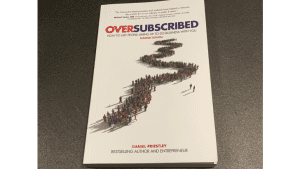
In the first section, the author explains the theory of supply and demand and how to become oversupplied in eight simple principles. The second part delivers a campaign marketing and sales methodology that will, Priestley claims, enable your own business to become oversubscribed. The third and shortest section describes the key people and the tools that are required to succeed in becoming oversubscribed.
An overview
The first section is fairly simplistic and merely looks at the economic theory of supply and demand, In fact, if you didn’t understand it properly before reading this book, you almost certainly will afterwards. Priestley’s idea is almost to aim to create a Veblen good with your products and services. The principles are not unique, and many other business books go far further. This section is a very easy read and most people reading it will think that it makes sense. It raises the question of whether you are actually doing it within your business.
The second section is a comprehensive framework of how to apply Priestley’s campaign-driven method to obtain oversubscription within your business. Like most methodologies, it does not work for every company. It does, however, provide a wealth of ideas that once considered fully, can be applied within a business. The section is divided into a cycle of five phases for a campaign. Each phase has several elements, and for some elements, Priestley gives an activity list for the reader to follow for their own company. The book does not explain how to do each activity. However, there is enough information in the text for the reader to have a go. This is the section with the real nuggets for the reader. If you haven’t considered some of these activities, they are worth having a go at. What you learn could be very useful for your business.
The final and shortest section talks about the four personas that every organisation needs to be successful and the tools they can use. While it rounds off the book nicely talking about people, culture and tools, it is very light.
What was it like?
The first section is easy to read. Whether the principles were good practice, best practice or principle is arguable. They are certainly common sense for most businesses to succeed, though it must be said that not all businesses follow this simple advice. The second section, while easy to read again required more thought and time to do so. The activities were explained simply though that does not mean that they were easy to complete. It took time to read this section merely because thinking about what the activities would mean for the company takes time. Some phases will be less relevant than others.
Is this the perfect book to base your strategy on? It depends. Not every company will succeed by trying to follow the oversubscribed methodology. One of the reasons is that while each phase is carefully laid out, there is a lot more to creating a successful campaign than just reading and applying the lessons from the book. It also depends on the nature of your business. However, what it does include are some very practical activities which many organisations can benefit from.
Would I read this book again? I would skim the first section and would definitely reread the second section for some of the ideas within it. That it is in a second edition demonstrates that others also see the benefits of the book. Few business books make a second edition and that this does is a good indication that it is a worthwhile read for many.
Enterprise Times was sent a review copy of this book by the publisher.

























